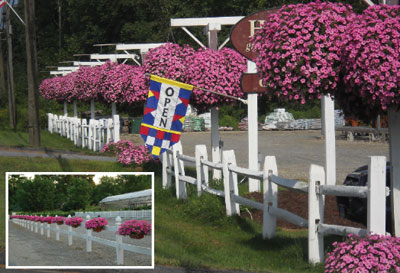
Features
Business
Marketing
Breaking Down Barriers – A Streetside Invitation to Stop and Shop
December 1, 2010 By Judy Sharpton
Garden centres are famous for being invisible. They often act under the misconception that the greenhouse or tables of plants out front tell customers what kind of business we are and customers will automatically come to us when they need something.
Garden centres are famous for being invisible. They often act under the misconception that the greenhouse or tables of plants out front tell customers what kind of business we are and customers will automatically come to us when they need something.

|
| What a difference a splash of colour can make to improve the curb appeal of a garden centre. In the inset picture, the combination of this permanent white resin fence and the Supertunia Vista Bubblegum planters stops traffic. In the main photo, large hanging baskets add height to this fence planting and suggest another product to keep in stock in large quantities. Advertisement
|
Add to those longstanding and often misguided views the desire to present an organic or rural look – unpainted rail fences, farm equipment or trucks and worn signage – and the recipe for invisibility is complete. I suspect many stores reflect a tendency on the part of ownership to maintain a background presence, believing the act of producing and offering quality plants to a community for many generations should be enough to encourage continued patronage.
Changes in the store’s surroundings can also impact streetside visibility. Once-rural stores have experienced sprawl, with development engulfing the location. While development can be a plus, providing more drive-by traffic and more customers, that positive impact can be impeded by more rigid signage restrictions. The store may even find itself prohibited by local bylaws from making any changes in signage under the threat of not being allowed to put up anything new, no matter how attractive the improvement may be.
To compound the confusion, many stores lack adequate parking to allow passersby to confidently make the turn. If it looks as if there’s no place to park, customers may elect to avoid the hassle, promising to return. Sometimes they don’t. Sometimes the urge to garden this weekend is displaced by other activities or another retailer provides easier access at a time when customers find it convenient to shop.
In a consumer marketplace dominated by image overload, a store can simply be lost in the clutter. Many garden centres are. Even stores that consider themselves destinations (a designation that is becoming more and more suspect) must reward the customer who makes the effort to visit with an inviting entrance and adequate, organized parking.
You need to give customers a reason to stop at your garden centre. You don’t want to hear the telltale phrase “I’ve been driving by here for years and always meant to stop in.” Streetside signage is key to encouraging customers to make time for your garden centre. Here’s where Proven Winners’ Supertunia Bubblegum becomes a marketing hero. Adding this plant to the front of the store won’t create additional parking but it will scream, “Stop here for great plants!” Several stores in the SWAS program experienced great success with various streetside installations. The only problem is keeping enough of the plant in stock to meet customer demand. The single colour planting acts not as a display garden but as a giant billboard. Once the infrastructure for the planting is in place, seasonal change-out of the pot-in-pot display is easy and quick. An eye-catching planting display such as this won’t take the place of a traditional sign that says “Garden Centre” but it will cause the customer to see that sign and turn in to the parking lot.
Judy Sharpton is a garden centre design and renovation specialist with 35 years of experience in advertising and promotion. She is the owner of Growing Places Marketing.
| Store Within A Store Beginning in the fall of 2009 and continuing through the 2010 selling season, Proven Winners and its three primary growing operations partnered with Growing Places Marketing to initiate a store development program for independent retailers designed specifically to increase sales, not only of Proven Winners products, but also of products throughout the store. Sales representatives from the three Proven Winners founding partners – EuroAmerican Propagators, Pleasant View Gardens and Four Star Greenhouses – identified retailer/growers with both the potential for sales growth and the desire to upgrade their store’s retail environment. The consultation program took two forms: Some stores elected to participate in a one-day, onsite collaborative meeting while others arranged consultations at trade events, including the Ohio Short Course and the Independent Garden Center Show in Chicago. In both venues, Judy Sharpton and the owners and staff of each store accomplished two objectives: to identify the location for a Proven Winners Store-Within-A-Store and to identify environmental issues that served as barriers to sales. In this series of articles, we will describe several of the environmental issues identified in this program that are common to many retailer/grower operations, the steps these stores took, with the help of Proven Winners and Growing Places Marketing, to alleviate those barriers, and the results of those decisions. |
Print this page